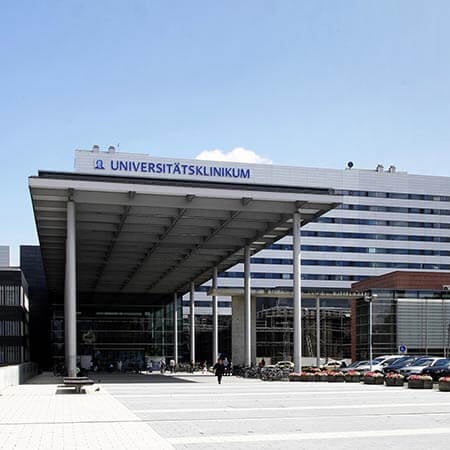Mitral valve insufficiency, or regurgitation, creates blood backflow into the heart. Such mitral valve disease causes fatigue or difficulty breathing because of insufficient blood supply.
The decision about the therapeutic method for valve regurgitation is made taking into consideration the features and rate of progression of the disease. With progressive disease, surgery might be required to prevent the worsening of the health condition. If the need for treatment is not met, mitral valve insufficiency causes heart failure or other serious complications.
Content
- Types of mitral valve insufficiency
- Treatment principles
- Surgery for mitral valve repair and replacement
- Minimally invasive surgery
- Complications of the disease
- Treatment of mitral valve insufficiency (prolapse) in European hospitals
- The cost of treatment in Europe
- How to organize treatment in Europe?
Types of mitral valve insufficiency
The mitral valve opens, letting blood into the left ventricle, and closes, pushing blood further. If it does not fully seal, some blood flows back, and this is basically what regurgitation is.
Mitral valve regurgitation can have a form of acute or chronic, congenital or acquired disease.
Valve changes, including mitral valve regurgitation, are often combined with other congenital heart diseases, which refer either to diseases of valve rings in general or to underdevelopment of the entire left half of the heart. However, congenital valve diseases with a normally developed left ventricle have been described, and those are mitral valve stenoses and mitral valve insufficiency. Congenital mitral valve stenoses are extremely rare. The congenital disease can be treated with heart surgery, and its choice depends on the type of lesion of the mitral valve structures: from dissection of the narrowed sections of the leaflets to mitral valve replacement. More often, the mitral valve is affected in cases of endocarditis or rheumatism, and these are not congenital causes that should be excluded first of all.
And again, congenital mitral valve regurgitation, which would necessitate early visit to cardiac surgeons, is extremely rare. But one of the most frequent cardiologic diagnoses recently, a mitral valve prolapse, requires management over the health condition. As a rule, it is diagnosed in completely asymptomatic patients at random examination based on a small noise, which used to be called "functional heart murmur" and was not paid special attention to. With the advent and introduction of echocardiography, the reasons for this noise became clearer. It is mostly caused by inaccurate closure of the valve cusps in relation to each other, as a result of which a trickle of blood at the moment of ventricular contraction goes backwards, seeping into the atrium. This can be caused by one of the sections of the flap flexing backward under pressure, "prolapsing" towards the atrium, and letting this trickle through. This is what a prolapse is.
The degree of mitral valve prolapse can vary from mild to severe regurgitation (backflow). This degree is clearly visible on echocardiography. If mitral valve prolapse is diagnosed in children, and there are no signs of heart failure, a child's health condition is likely to be normal and no restrictions for the usual healthy lifestyle should be set. However, generally, parents need to be especially careful about a child’s colds, sore throats, decayed teeth, so they do not cause an infection of the mitral valve, which is more likely to occur in a child with prolapse than in other children. A doctor should inform you about lifestyle conditions you need to pay attention to.
Treatment principles
The mitral valve of the heart is directly involved in the blood pumping process, being subjected to the constant impact of high blood flow pressure. It is the most susceptible to abnormalities and diseases than other parts of the heart. Functional dysfunction of this valve is expressed in incomplete blocking of the valve orifice by the flaps. This disturbs the normal blood flow, forcing the heart to work with an increased load. The causes of this dysfunction are not yet fully clarified but need to be searched for when deciding on the treatment method. They may be:
- Connective tissue abnormalities, such as dysplasia manifested by increased tissue flexibility.
- Infectious diseases resulting in inflammation of the inner lining of the heart, which also covers valves (connective tissue develops on the mitral valve leaflets, scars and adhesions form, leading to sagging of the leaflets and incomplete closure of the entrance into the atrium).
- Diseases of myocardium and cardiac muscles.
- Deposition of mineral salts on the walls of the valve.
- Rheumatism and other health conditions.
At the early stages, mitral valve insufficiency can be treated by conservative therapeutic methods combined with diet and moderate physical activity. In more complex cases, mitral valve repair surgery may be required, which implies a surgical intervention to reconstruct the pathologically changed valve.
Mitral valve replacement surgery is necessary in the presence of the following indications:
- Inability to perform an effective repair surgery.
- Severe fibrosis (formation of a thick layer of connective tissue) of the valve cusps.
- Pronounced calcinosis on the leaflets (calcium deposits).
Surgery for mitral valve repair and replacement
A variant of heart surgery for valve repair is an operation using different suture plasty techniques. During such repair procedures, the surgeon removes calcified deposits or restores the structure of altered tendon chords that control the movement of the flaps.
An example of such a repair surgery is mitral valve annuloplasty, which restores the function of the valve with a rigid or flexible support ring. It is fixed to the walls of the heart at the level of the orifice connecting the atrium to the ventricle. By implanting such a supportive ring, the diameter of the atrial-ventricular orifice is reduced, resulting in more complete closure of the cusps and normalization of the intracardiac blood flow, eliminating mitral valve regurgitation.
The radical method of mitral valve treatment is valve replacement. In the case of sharply pronounced morphological changes of the patient's own valve, when its repair is impossible, the valve is removed with subsequent prosthetics. Surgical mitral valve prosthetics are performed on the non-functioning heart with the use of an artificial circulatory system.
Such surgery involves the use of modern mechanical and biological valves (artificial heart valves).
Mechanical artificial heart valves are very reliable, last a lifetime, and do not need to be replaced, but require constant intake of special medications to reduce blood clotting.
Biological valves can deteriorate over time, and the lifespan of these valves is highly dependent on the age of the patient, related health problems, and other conditions. The degradation of biological valves slows down considerably with age. The decision about which valve is the best option in a particular situation of mitral valve regurgitation is made individually prior to the surgery in a mandatory conversation between the surgeon and the patient.
Minimally invasive surgery
Minimally invasive methods of surgery imply valve replacement without opening the chest and connecting to the artificial circulation system.
Since in minimally invasive surgery, access to the heart is done through a right lateral minithoracotomy, where the length of the skin incision is about 7 cm, the skeletal function of the chest is preserved, i.e., its integrity is not compromised, while, on contrary, in the traditional access (through a median sternotomy), the length of the skin incision is about 20 cm, and, the sternum must be sawed along the median line to perform the heart surgery. Because the thorax remains intact, the risk of developing such complications as postoperative instability of the sternum is eliminated.
Less surgical trauma and preservation of thoracic skeletal framework function after minithoracotomy allows for early activation and rehabilitation of patients, thus reducing the duration of hospital treatment. Besides, most patients are very satisfied with the cosmetic result after surgery.
Complications of the disease
A mild form of mitral valve insufficiency (regurgitation) often does not cause any concern. Advanced mitral valve insufficiency may cause such health conditions as atrial fibrillation (abnormal heart rate), endocarditis, and pulmonary hypertension.
With heart failure, the heart is unable to pump blood at the intensity needed for normal body function. A severe form of mitral valve insufficiency puts extra strain on the heart because of the need to pump more blood. The left ventricle enlarges and, if the health condition is left untreated, it weakens. This can lead to heart failure. Fluid accumulates in the lungs as a result of mitral valve insufficiency (prolapse) and increases pressure, which can eventually lead to suppression of the right side of the heart. The patients with heart failure may experience difficulty breathing and fatigue. They may also wake up at night with shortness of breath.
Atrial fibrillation is an irregular heartbeat, in which the upper chambers of the heart contract chaotically and rapidly. Atrial fibrillation can cause blood clots. These clots can leave the heart and travel through the bloodstream; they often travel to the brain, causing a stroke. Other types of irregular heartbeat (arrhythmias) are also possible with mitral valve regurgitation.
Endocarditis is an infection of the inner lining of the heart. This infection usually affects one of the heart valves, especially if it has already been damaged. With mitral valve insufficiency (prolapse), it is more susceptible to infection than in a healthy condition. Doctors used to recommend that some patients with mitral valve regurgitation take antibiotics before certain medical procedures to prevent the development of the disease, but antibiotics are no longer considered necessary for most patients with mitral valve insufficiency or prolapse.
Treatment of mitral valve insufficiency (prolapse) in European hospitals
Cardiac surgery performed in European hospitals has recently become exemplary in terms of performance. Mitral valve replacement is prominent among surgical interventions. In large European hospitals, at least 400 heart valve surgeries are conducted annually.
There are two main directions of surgical procedures European surgeons specialize in. These include valve repair surgery and valve replacement surgery. In Europe, it is preferred to preserve the natural valve by performing repair surgery, if possible.
The list of top hospitals for the treatment of mitral valve insufficiency (prolapse) in Europe and services these hospitals provide is available on the Booking Health website.
The cost of treatment in Europe
The prices for the most common procedures for the treatment of mitral valve insufficiency are listed below:
- The cost of treatment with mitral valve repair starts from 10,025 EUR.
- The cost of treatment with minimally invasive valve replacement starts at 10,082 EUR.
- The cost of treatment with a Mitralign System starts at 29,066 EUR.
- The price for diagnostics starts at 467 EUR.
- The price for cardiac rehabilitation starts at 566 EUR.
You can find more related prices for different treatments of mitral valve prolapse on the Booking Health website.
How to organize treatment in Europe?
The organization of treatment in European hospitals may seem wearisome, and it probably is if doing it on your own.
Booking Health resolves all the organizational issues, even those you consider difficult to deal with. Booking Health is here for you to offer assistance in every step of your treatment journey.
To know more about the services Booking Health provides, please fill in the request form on the website, and a medical advisor will contact you as soon as possible.
Authors:
This article was edited by medical experts, board-certified doctors Dr. Nadezhda Ivanisova, and Dr. Bohdan Mykhalniuk. For the treatment of the conditions referred to in the article, you must consult a doctor; the information in the article is not intended for self-medication!
Our editorial policy, which details our commitment to accuracy and transparency, is available here. Click this link to review our policies.



















